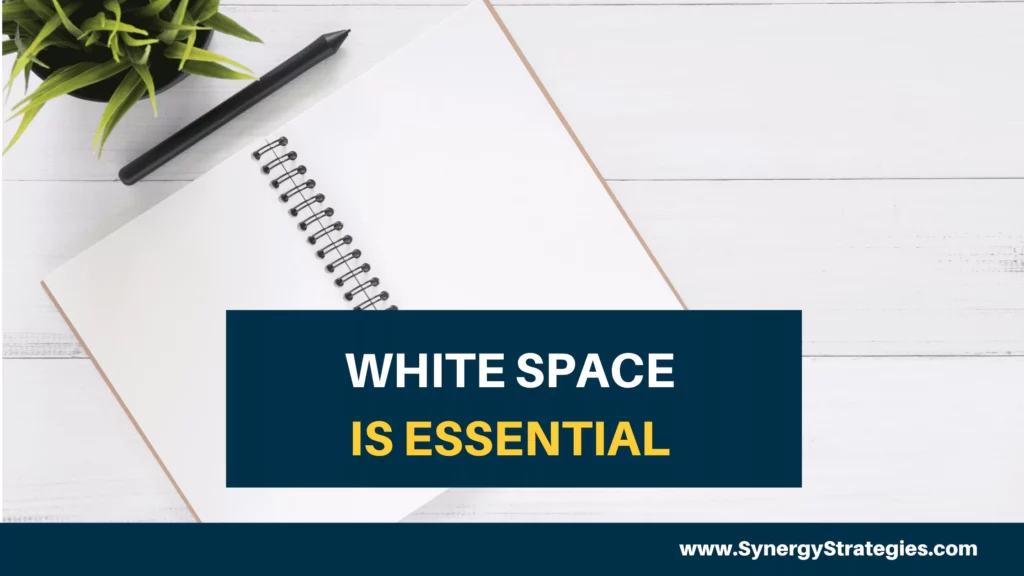White space is the space between the tasks, projects, meetings and demands we have each day. White space has NOTHING in it, on purpose. Because we have a hard time with silence and emptiness, we feel more comfortable filling the white space. Think of an “opening” on your calendar, a spot on your desk, an empty cabinet, or a blank spot on a document. In graphic design, beginners often fill white space by putting too much on a page, crowding words and images, etc. They must learn that part of the art and the psychology of people digesting the message is white space. In recent years, there has been a clear shift to more white space. The millennial demographic generally enjoys and promotes minimalism. While this can go against the values of previous generations who were taught to save and reuse, the younger generation works to simplify and reduce “extra” stuff that creates distraction and noise because it takes up energy and emotions in their space. They want white space. They need white space. We all do. As the world increases in speed of change and innovation coming at us with increased frequency, humans need white space.
Physical
White space (clear desk, clear notebook, etc.) is proven to help us think better and work faster. When we have “stuff” in our space, it is distracting, even if it is only subconsciously distracting. Consider the new trend of the co-working spaces. Really what is needed is a surface, chair and needed plug ins. How do you create physical white space? Make a point to clear your desk at the end of your workday. Pick up the house at the end of the day. By creating clear space, it opens energy and needed “oxygen” to do what you need to do rather then feeling overwhelmed, distracted, and vacillating to different things. Having homes for things like keys, shoes and such helps to keep you organized and quickly to regain white space when it quickly disappears in a busy day. Having systems and organization helps achieve order intentionally by just following your system (i.e. closet clothes by color or season, bookshelf by topic, files, etc.)
Time
White space is not just down time to relax … it is time in our day with unplanned margin. We need white space in our workday and in our personal lives. Ideally in an 8-hour day, there would be 2 hours of unscheduled open white space. You don’t plan what to do in white space that reveals itself in the day. Things always do. Some people misunderstand this reality and don’t plan their day. As a result, their day tells them what to do. Plan your day and tell it what to do but provide yourself with at least 2 hours in your day of white space for the unexpected and things that arise that day (team member who emails, someone who needs to talk, child who needs support, project that takes longer than planned, etc.). The average person has 16 hours in their day (after a healthy 8 hours of sleep), it is said the average human spends about 4 hours on human essentials (eating, getting ready, bathroom, travel, prepping, etc.) (this is a white space we don’t even realize but gets used daily). That leaves 12 hours and 8 of those are often in work, leaving 4 hours for yourself for hobbies, kids, R&R, etc. Of these 4 hours, it would be ideal to have 30-60 minutes of white space (unplanned) to respond to the day/needs. It can feel excessive to break down hours like that, but if you have ever wondered “where does all my time go?” it is often in some of the uncalculated items like above. It is those uncalculated activities that accidentally eat our white space that is needed for mental rejuvenation. I have found that you must actually plan and budget white space and then work to hold the white space, so you have it to use in the moment. It does require work, because as said already, our natural tendency is to fill it with tasks. Personal white space is for you to rest and have self-care.
Communication
Just like the graphics example above, white space is needed in our messages and conversations. It is the art of asking questions and allowing silence for people to think and process. Often people jump in during silence because we are uncomfortable with silence. Giving margin for people to have a heads up about news, announcements, and upcoming conversations so they can think and prepare. Giving margin in meetings for people to add something needed to an agenda or have a discussion for something that has come up in the meeting is important. It allows us to create in the moment and to have space for the needs of the moment. If we are running so fast and driving things so strongly, we squeeze out the white space which is needed to process, absorb, ask questions, find new insights, deepen understanding and just be present in the moment. This is all very important to our mental, emotional, and physical health.
It is hard to clear white space… that is why it is important to draw attention to it, because naturally white space is absorbed. It requires work to create and maintain white space, but it is a sage gift for balance, margin, and new thought/insight to come. Without white space, our environment, calendars, mind and energy are crowded and congested. White space brings calm, centering, awareness, and balance to our naturally busy world.
- Where do you currently have white space?
- Where could you use more white space?
- What would you have to be intentional about to create that white space?
- What would this white space do for you?
- What is your first step to do today to create this space for yourself?






